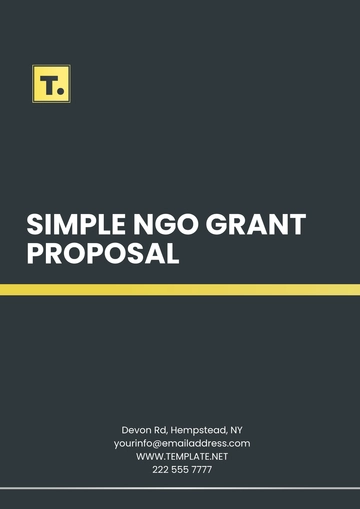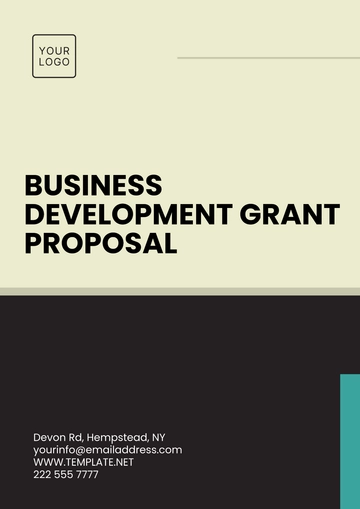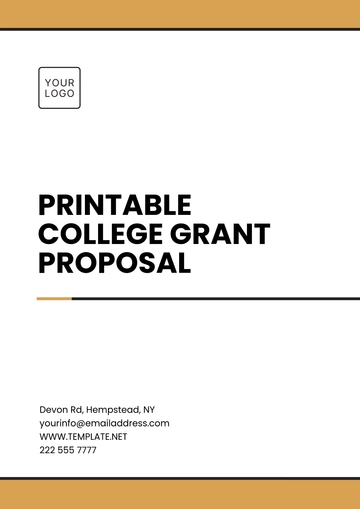Free Administration Grant Proposal

Executive Summary
Our grant proposal, "Empowering Communities Through Comprehensive Administration," endeavors to address the multifaceted challenges hindering the prosperity of communities across the nation. We recognize that sustainable growth and well-being stem from a holistic approach that targets key areas such as education, healthcare, infrastructure, and economic development. By strategically deploying resources and support in these domains, our proposal aims to uplift communities, bolster resilience, and cultivate environments where all individuals can thrive. Through collaborative efforts and targeted interventions, we aspire to create lasting positive impacts that extend far beyond the duration of this grant.
Introduction
In the landscape of community development, myriad obstacles impede progress and perpetuate cycles of inequality and stagnation. From disparities in access to education and healthcare to the crumbling infrastructure and economic hardships plaguing many regions, the challenges are vast and interconnected. Our grant proposal emerges as a response to these pressing needs, grounded in the belief that comprehensive administration is pivotal in catalyzing sustainable change. By delving into the root causes of community disparities and adopting a multifaceted approach, we aim not merely to alleviate symptoms but to cultivate the conditions for long-term flourishing. Through this proposal, we embark on a journey to empower communities, foster inclusivity, and pave the way for a brighter tomorrow for all residents.
Needs Assessment
Education: Many communities lack access to quality education due to underfunded schools, outdated resources, and a lack of educational programs. This leads to lower academic achievement and limited opportunities for students.
Healthcare: Healthcare disparities are prevalent in underserved communities, with limited access to medical facilities, healthcare professionals, and preventive care services.
Infrastructure: Aging infrastructure hinders community development and economic growth, with issues such as inadequate transportation systems, lack of affordable housing, and outdated utilities
Economic Development: High unemployment rates, limited job opportunities, and a lack of resources for entrepreneurship contribute to economic challenges within communities.
Objectives
Education: Improve access to quality education through the implementation of educational programs, investment in school infrastructure, and support for teachers and students.
Healthcare: Enhance access to healthcare services by expanding medical facilities, providing resources for preventive care programs, and increasing the number of healthcare professionals in underserved areas.
Infrastructure: Upgrade infrastructure to support community development, including investments in transportation, housing, utilities, and environmental sustainability initiatives.
Economic Development: Stimulate economic growth by providing resources for job training programs, supporting small businesses, and fostering entrepreneurship within communities.
Scope
The scope of our grant proposal encompasses a wide range of activities and initiatives aimed at addressing the complex challenges faced by communities. Our efforts will focus on targeted interventions in the following areas:
Education: This includes initiatives to improve access to quality education, enhance educational outcomes, and support lifelong learning. Activities may involve investment in school infrastructure, curriculum development, teacher training programs, and student support services.
Healthcare: Our scope within healthcare extends to initiatives aimed at improving access to healthcare services, promoting preventive care, and addressing healthcare disparities. This may involve the establishment of community health centers, expansion of medical facilities, recruitment of healthcare professionals, and implementation of health education programs.
Infrastructure: Infrastructure development plays a crucial role in community resilience and economic prosperity. Our scope within infrastructure encompasses projects such as transportation improvements, affordable housing initiatives, utilities upgrades, and environmental sustainability efforts.
Economic Development: Economic empowerment is vital for community growth and well-being. Within this scope, we will support initiatives aimed at job creation, small business development, entrepreneurship, and workforce training programs.
While our primary focus will be on these four areas, we recognize the interconnected nature of community development and will strive to implement integrated strategies that address overlapping challenges comprehensively. Additionally, our scope will be flexible and adaptable, allowing for responsiveness to the unique needs and priorities of each community served by this grant. Through targeted interventions and collaborative partnerships, we aim to maximize the impact of our efforts and create sustainable positive change at the local level.
Methodology
Education: Collaborate with local schools to identify needs and develop tailored educational programs. Provide funding for infrastructure improvements and technology upgrades. Offer professional development opportunities for teachers.
Healthcare: Partner with healthcare providers to expand medical services and establish community health centers. Offer grants for preventive care initiatives and medical equipment. Recruit and train healthcare professionals to serve in underserved areas.
Infrastructure: Conduct assessments of existing infrastructure and prioritize areas for improvement. Invest in transportation projects, affordable housing initiatives, renewable energy systems, and environmental conservation efforts.
Economic Development: Provide grants and loans to support job training programs, small business development, and entrepreneurship ventures. Offer mentorship and technical assistance to aspiring entrepreneurs.
Evaluation Plan
Education: Measure academic performance indicators, student attendance rates, and teacher satisfaction surveys.
Healthcare: Track healthcare utilization rates, patient satisfaction scores, and health outcomes data.
Infrastructure: Assess the impact of infrastructure improvements on economic development, environmental sustainability, and quality of life indicators.
Economic Development: Monitor job creation, business growth, and economic indicators such as unemployment rates and GDP growth.
Timeline
The project is anticipated to span over a period of one year.
Task | Duration |
|---|---|
Systems Audit | 3 months |
Planning | 3 months |
System Implementation | 4 months |
Training and Development | 2 months |
Budget
The projected budget is detailed below:
Task | Estimated Cost |
|---|---|
Personnel | $10,000 |
Program Expenses | $20,000 |
Equipment | $30,000 |
Training | $15,000 |
Total | $75,000 |
Impact and Benefits
The implementation of our grant proposal is poised to yield profound impacts and tangible benefits across various facets of community life. Through targeted interventions in education, healthcare, infrastructure, and economic development, we anticipate the following outcomes:
Enhanced Educational Opportunities: By investing in educational programs, infrastructure improvements, and teacher support, we anticipate a significant increase in academic achievement, graduation rates, and opportunities for lifelong learning. Empowering students with access to quality education equips them with the skills and knowledge necessary to pursue higher education and succeed in the workforce.
Improved Health and Well-being: Expanded access to healthcare services, preventive care initiatives, and healthcare professionals in underserved areas will lead to improved health outcomes, reduced healthcare disparities, and enhanced overall well-being within communities. By prioritizing preventive care and early intervention, we aim to mitigate the burden of chronic diseases and promote healthier lifestyles among residents.
Strengthened Infrastructure: Investments in infrastructure projects such as transportation upgrades, affordable housing initiatives, and environmental sustainability efforts will yield lasting benefits for communities. Improved transportation networks facilitate economic mobility and access to essential services, while sustainable housing initiatives promote stability and resilience. Additionally, environmental conservation efforts contribute to a healthier environment and enhanced quality of life for residents.
Economic Growth and Opportunity: Through support for job training programs, small business development, and entrepreneurship ventures, we anticipate a revitalization of local economies and the creation of new opportunities for employment and economic advancement. By fostering a conducive environment for business growth and innovation, we empower individuals to pursue their entrepreneurial aspirations and contribute to the economic prosperity of their communities.
Risks and Mitigation
While our grant proposal holds great potential for transformative change, it is essential to acknowledge and address potential risks and challenges that may arise during implementation. Key risks include:
Resource Constraints: Limited funding and resources may pose challenges in fully realizing the proposed initiatives. To mitigate this risk, we will explore diverse funding sources, prioritize high-impact projects, and seek collaborations with government agencies, philanthropic organizations, and private sector partners.
Community Resistance: Resistance or skepticism from community members or local authorities may impede progress and hinder the adoption of proposed interventions. To address this risk, we will engage in transparent communication, community outreach, and participatory decision-making processes to garner support and build trust among stakeholders.
External Factors: External factors such as changes in political landscape, economic downturns, or unforeseen events (natural disasters, pandemics) may disrupt project timelines and objectives. To mitigate these risks, we will develop contingency plans, maintain flexibility in project implementation, and prioritize resilience-building measures to adapt to changing circumstances.
Capacity Building: Limited institutional capacity or expertise within local organizations may pose challenges in effectively implementing and sustaining proposed initiatives. To address this risk, we will invest in capacity-building efforts, provide training and technical assistance to local partners, and foster collaborations with experienced stakeholders to enhance project management and implementation capabilities.
Conclusion
Comprehensive administration plays a crucial role in addressing the multifaceted challenges faced by communities. By implementing targeted strategies in education, healthcare, infrastructure, and economic development, we can empower communities to thrive and build a brighter future for all residents. With the support of this grant, we can make meaningful progress towards creating sustainable, equitable, and resilient communities.
- 100% Customizable, free editor
- Access 1 Million+ Templates, photo’s & graphics
- Download or share as a template
- Click and replace photos, graphics, text, backgrounds
- Resize, crop, AI write & more
- Access advanced editor
Transform your grant proposals with Template.net's Administration Grant Proposal Template. Easily editable and customizable, this template empowers you to tailor your proposals to your organization's needs. With seamless integration into our AI Editor Tool, crafting compelling grant proposals has never been easier. Unlock your potential today!
You may also like
- Business Proposal
- Research Proposal
- Proposal Request
- Project Proposal
- Grant Proposal
- Photography Proposal
- Job Proposal
- Budget Proposal
- Marketing Proposal
- Branding Proposal
- Advertising Proposal
- Sales Proposal
- Startup Proposal
- Event Proposal
- Creative Proposal
- Restaurant Proposal
- Blank Proposal
- One Page Proposal
- Proposal Report
- IT Proposal
- Non Profit Proposal
- Training Proposal
- Construction Proposal
- School Proposal
- Cleaning Proposal
- Contract Proposal
- HR Proposal
- Travel Agency Proposal
- Small Business Proposal
- Investment Proposal
- Bid Proposal
- Retail Business Proposal
- Sponsorship Proposal
- Academic Proposal
- Partnership Proposal
- Work Proposal
- Agency Proposal
- University Proposal
- Accounting Proposal
- Real Estate Proposal
- Hotel Proposal
- Product Proposal
- Advertising Agency Proposal
- Development Proposal
- Loan Proposal
- Website Proposal
- Nursing Home Proposal
- Financial Proposal
- Salon Proposal
- Freelancer Proposal
- Funding Proposal
- Work from Home Proposal
- Company Proposal
- Consulting Proposal
- Educational Proposal
- Construction Bid Proposal
- Interior Design Proposal
- New Product Proposal
- Sports Proposal
- Corporate Proposal
- Food Proposal
- Property Proposal
- Maintenance Proposal
- Purchase Proposal
- Rental Proposal
- Recruitment Proposal
- Social Media Proposal
- Travel Proposal
- Trip Proposal
- Software Proposal
- Conference Proposal
- Graphic Design Proposal
- Law Firm Proposal
- Medical Proposal
- Music Proposal
- Pricing Proposal
- SEO Proposal
- Strategy Proposal
- Technical Proposal
- Coaching Proposal
- Ecommerce Proposal
- Fundraising Proposal
- Landscaping Proposal
- Charity Proposal
- Contractor Proposal
- Exhibition Proposal
- Art Proposal
- Mobile Proposal
- Equipment Proposal
- Student Proposal
- Engineering Proposal
- Business Proposal





























